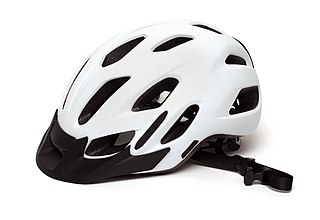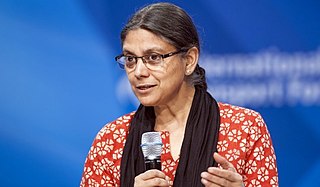
Road traffic safety refers to the methods and measures used to prevent road users from being killed or seriously injured. Typical road users include pedestrians, cyclists, motorists, vehicle passengers, horse riders, and passengers of on-road public transport.

A bicycle helmet is a type of helmet designed to attenuate impacts to the head of a cyclist in collisions while minimizing side effects such as interference with peripheral vision.

Risk compensation is a theory which suggests that people typically adjust their behavior in response to perceived levels of risk, becoming more careful where they sense greater risk and less careful if they feel more protected. Although usually small in comparison to the fundamental benefits of safety interventions, it may result in a lower net benefit than expected or even higher risks.

The National Traffic and Motor Vehicle Safety Act was enacted in the United States in 1966 to empower the federal government to set and administer new safety standards for motor vehicles and road traffic safety. The Act was the first mandatory federal safety standards for motor vehicles. The Act created the National Highway Safety Bureau. The Act was one of a number of initiatives by the government in response to increasing number of cars and associated fatalities and injuries on the road following a period when the number of people killed on the road had increased 6-fold and the number of vehicles was up 11-fold since 1925. The reduction of the rate of death attributable to motor-vehicle crashes in the United States represents the successful public health response to a great technologic advance of the 20th century—the motorization of America.

Motorcycle safety is the study of the risks and dangers of motorcycling, and the approaches to mitigate that risk, focusing on motorcycle design, road design and traffic rules, rider training, and the cultural attitudes of motorcyclists and other road users.

Bicycle safety is the use of road traffic safety practices to reduce risk associated with cycling. Risk can be defined as the number of incidents occurring for a given amount of cycling. Some of this subject matter is hotly debated: for example, which types of cycling environment or cycling infrastructure is safest for cyclists. The merits of obeying the traffic laws and using bicycle lighting at night are less controversial. Wearing a bicycle helmet may reduce the chance of head injury in the event of a crash.

Motorcycling is the act of riding a motorcycle. For some people, motorcycling may be the only affordable form of individual motorized transportation, and small-displacement motorcycles are the most common motor vehicle in the most populous countries, including India, China and Indonesia.

A cycle track, separated bike lane or protected bike lane is an exclusive bikeway that has elements of a separated path and on-road bike lane. A cycle track is located within or next to the roadway, but is made distinct from both the sidewalk and general purpose roadway by vertical barriers or elevation differences.

Lane splitting is riding a bicycle or motorcycle between lanes or rows of slow moving or stopped traffic moving in the same direction. It is sometimes called whitelining, or stripe-riding. This allows riders to save time, bypassing traffic congestion, and may also be safer than stopping behind stationary vehicles.

The Hurt Report, officially Motorcycle Accident Cause Factors and Identification of Countermeasures, was a motorcycle safety study conducted in the United States, initiated in 1976 and published in 1981. The report is named after its primary author, Professor Harry Hurt.

A traffic collision, also called a motor vehicle collision, occurs when a vehicle collides with another vehicle, pedestrian, animal, road debris, or other moving or stationary obstruction, such as a tree, pole or building. Traffic collisions often result in injury, disability, death, and property damage as well as financial costs to both society and the individuals involved. Road transport is the most dangerous situation people deal with on a daily basis, but casualty figures from such incidents attract less media attention than other, less frequent types of tragedy. The commonly used term car accident is increasingly falling out of favor with many government departments and organizations, with the Associated Press style guide recommending caution before using the term.

Australia was the first country to make wearing bicycle helmets mandatory. The majority of early statistical data regarding the effectiveness of bicycle helmets originated from Australia. Their efficacy is still a matter of debate.

Some countries and lower jurisdictions have enacted laws or regulations which require cyclists to wear a helmet in certain circumstances, typically when riding on the road or a road-related area. In some places this requirement applies only to children under a certain age, while in others it applies to cyclists of all ages.

Traffic collisions in India are a major source of deaths, injuries and property damage every year. The National Crime Records Bureau (NCRB) 2021 report states that there were 155,622 fatalities, highest since 2014, out of which 69,240 deaths were due to two-wheelers. A study by Insurance Institute for Highway Safety, U.S. shows that the use of seat belts significantly reduces the risks and injuries from road accidents, and yet there is no enforcement on use of seat belts in cars. A study by IIT Delhi points out that the national highways constitute only 2% of the length of roads in India, but they account for 30.3% of total road accidents and 36% of deaths.

Prof. Geetam Tiwari is currently the TRIPP Chair Professor at the Department of Civil Engineering of the Indian Institute of Technology in New Delhi, India.

People who are driving as part of their work duties are an important road user category. First, workers themselves are at risk of road traffic injury. Contributing factors include fatigue and long work hours, delivery pressures, distractions from mobile phones and other devices, lack of training to operate the assigned vehicle, vehicle defects, use of prescription and non-prescription medications, medical conditions, and poor journey planning. Death, disability, or injury of a family wage earner due to road traffic injury, in addition to causing emotional pain and suffering, creates economic hardship for the injured worker and family members that may persist well beyond the event itself.
Traffic Injury Prevention is a bimonthly peer-reviewed academic journal covering the prevention of injuries resulting from traffic accidents. It was established in 1999 as the Journal of Crash Prevention and Injury Control, obtaining its current name in 2002. It is the official journal of the Association for the Advancement of Automotive Medicine, the International Traffic Medicine Association, the International Research Council on the Biomechanics of Impact, and the International Council on Alcohol Drugs and Traffic Safety. The editor-in-chief is David C. Viano. According to the Journal Citation Reports, the journal has a 2014 impact factor of 1.413, ranking it 95th out of 162 journals in the category "Public, Environmental & Occupational Health".

Nemkumar Banthia FRSC, is an Indian-born Canadian engineer and professor of civil engineering at the University of British Columbia and the CEO of IC-IMPACTS. He is best known for his research in the fields of cement-based and polymer-based fiber reinforced composites, particularly on testing and standardization, fracture behavior, strain-rate effects, durability and development of sustainable materials.

Prem Saran Satsangi is the eighth and current Sant Satguru of Radhasoami Faith, Dayalbagh. He holds the Emeritus Chair from the East of the Integrated East-West Forum at The Science of Consciousness Conferences since 2012. He is the chairman of Advisory Committee on Education, Dayalbagh Educational Institute.
Durai Sundar is an Indian computational biologist, bioinformatician and the current Head of the Department of Biochemical Engineering and Biotechnology at the Indian Institute of Technology, Delhi. He is known for his studies in the fields of genome editing tool designing, biological studies of natural drugs and metabolic engineering as well as for his participation in the Indo-Japanese collaborative research initiatives on anti-cancer drug development and is a life member of the National Academy of Sciences, India.


















